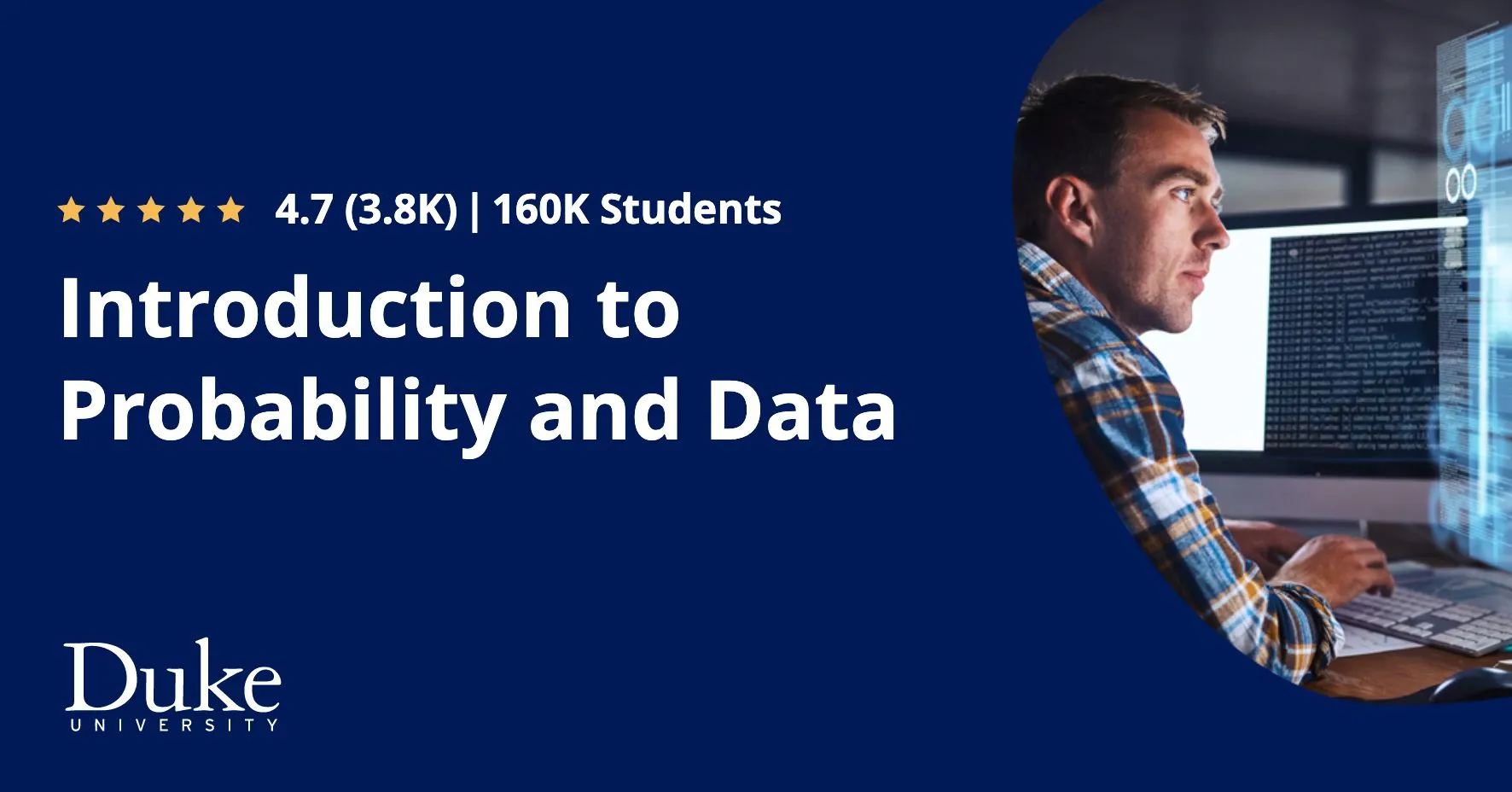
Introduction to Probability and Data with R 
This course provides an introduction to probability theory, Bayes' rule, and data exploration and sampling using the R programming language. Gain the skills to analyze and interpret data with confidence. ▼
ADVERTISEMENT
Course Feature
![]() Cost:
Cost:
Free
![]() Provider:
Provider:
Coursera
![]() Certificate:
Certificate:
No Information
![]() Language:
Language:
English
![]() Start Date:
Start Date:
Self Paced
Course Overview
❗The content presented here is sourced directly from Coursera platform. For comprehensive course details, including enrollment information, simply click on the 'Go to class' link on our website.
Updated in [March 06th, 2023]
This course, Introduction to Probability and Data with R, provides an introduction to sampling and exploring data, as well as basic probability theory and Bayes' rule. Students will learn about various types of sampling methods and how they can affect the scope of inference. Exploratory data analysis techniques such as numeric summary statistics and basic data visualization will also be covered. Additionally, students will be guided through installing and using R and RStudio (free statistical software) for lab exercises and a final project. This course serves as a foundation for the inference and modeling courses in the Specialization.
[Applications]
After completing this course, students should be able to apply the concepts and techniques learned to their own data sets. They should be able to use R and RStudio to explore data, calculate summary statistics, and create basic data visualizations. Additionally, they should be able to apply basic probability theory and Bayes' rule to solve problems.
[Career Paths]
1. Data Scientist: Data Scientists use their knowledge of statistics, mathematics, and computer science to analyze large datasets and uncover insights. They use a variety of tools and techniques, such as machine learning, to develop predictive models and uncover patterns in data. The demand for Data Scientists is growing rapidly, as organizations increasingly rely on data-driven decision making.
2. Business Analyst: Business Analysts use their knowledge of data analysis and business processes to identify opportunities for improvement and develop strategies to increase efficiency and profitability. They use data to identify trends and develop insights that can be used to inform business decisions. Business Analysts are in high demand, as organizations increasingly rely on data-driven decision making.
3. Data Engineer: Data Engineers are responsible for designing, building, and maintaining data systems. They use their knowledge of databases, programming languages, and software engineering to develop data pipelines and data warehouses. Data Engineers are in high demand, as organizations increasingly rely on data-driven decision making.
4. Data Visualization Specialist: Data Visualization Specialists use their knowledge of data analysis and visualization techniques to create interactive visualizations that help people understand complex data. They use a variety of tools and techniques, such as Tableau and D3.js, to create visualizations that can be used to inform decision making. The demand for Data Visualization Specialists is growing rapidly, as organizations increasingly rely on data-driven decision making.
[Education Paths]
1. Bachelor of Science in Statistics: This degree program provides students with a comprehensive understanding of the principles of statistics and data analysis. Students learn how to use statistical software to analyze data, interpret results, and make predictions. They also learn how to design experiments, develop models, and interpret results. This degree is becoming increasingly popular as businesses and organizations rely more heavily on data-driven decision making.
2. Master of Science in Data Science: This degree program focuses on the application of data science techniques to solve real-world problems. Students learn how to use machine learning algorithms, develop predictive models, and analyze large datasets. They also learn how to use data visualization tools to communicate their findings. This degree is becoming increasingly popular as businesses and organizations rely more heavily on data-driven decision making.
3. Doctor of Philosophy in Applied Statistics: This degree program focuses on the application of statistical methods to solve real-world problems. Students learn how to use statistical software to analyze data, interpret results, and make predictions. They also learn how to design experiments, develop models, and interpret results. This degree is becoming increasingly popular as businesses and organizations rely more heavily on data-driven decision making.
4. Master of Science in Business Analytics: This degree program focuses on the application of data science techniques to solve business problems. Students learn how to use machine learning algorithms, develop predictive models, and analyze large datasets. They also learn how to use data visualization tools to communicate their findings. This degree is becoming increasingly popular as businesses and organizations rely more heavily on data-driven decision making.
Course Provider

Provider Coursera's Stats at AZClass
Discussion and Reviews
0.0 (Based on 0 reviews)
Explore Similar Online Courses

Customizing Django Templates Course

Visualizing Time Series Data in Python

Python for Informatics: Exploring Information

Social Network Analysis

Introduction to Systematic Review and Meta-Analysis

The Analytics Edge

DCO042 - Python For Informatics

Causal Diagrams: Draw Your Assumptions Before Your Conclusions

Whole genome sequencing of bacterial genomes - tools and applications

The Data Analyst Course: Complete Data Analyst Bootcamp

Data Analysis in Excel


Start your review of Introduction to Probability and Data with R